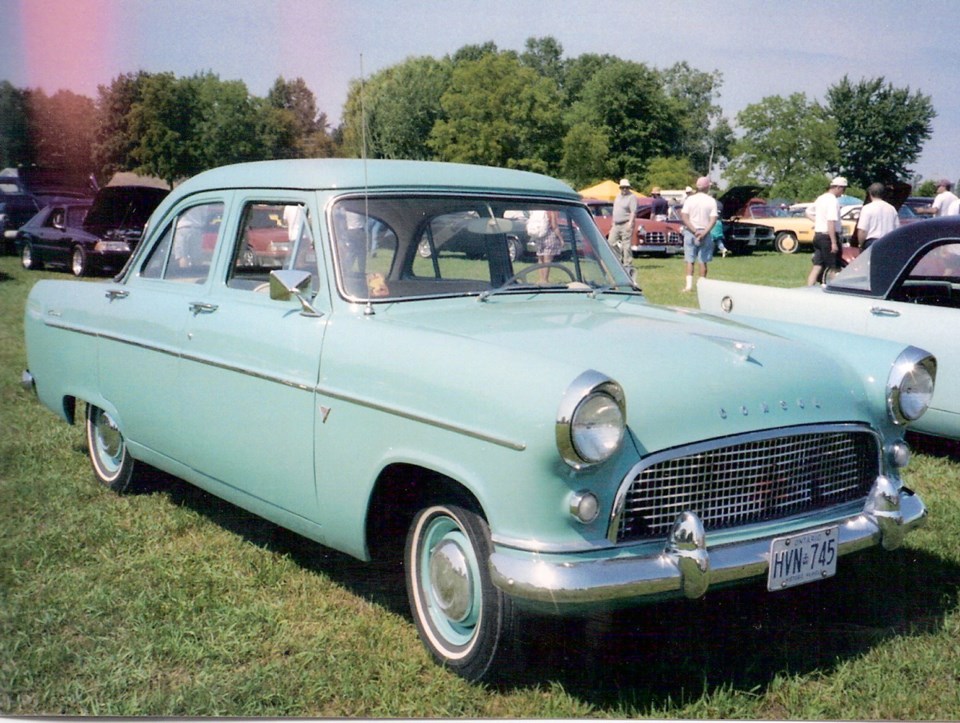The first Anglias and Prefects that Ford of England imported to North America after the Second World War were pretty basic cars. Those “captive imports” had tiny long-stroke, side-valve four-cylinder engines, mechanical brakes and solid front axles on transverse leaf springs. This 1930s technology made them marginal for our driving conditions.
Ford knew it desperately needed modern engineering, and produced the new four-cylinder Consul model in 1950. There was also a six-cylinder Zephyr clone, but it was higher-priced and didn’t have the Consul’s popularity.
In addition to regular contemporary technology, they introduced the MacPherson strut front suspension, invented by an American engineer named Earl S. MacPherson while he was at General Motors. It was originally intended for the small postwar Chevrolet Cadet that was never produced. MacPherson moved to Ford, and his strut made its appearance on the Consul.
Consul styling was clearly influenced by American cars, and it enjoyed popularity as a pleasant and economical car despite its modest 47 horsepower. Its clever suspended brake and clutch pedals were soon imitated by the rest of the industry.
In 1956, Ford replaced the Consul with our subject, the Consul II. It had an even more Americanized appearance that resembled the contemporary American Ford. It came as a four-door sedans, two-door convertibles and as a station wagon.
The Consul II had unit construction and a full envelope body with horizontal lines, slightly hooded headlamps and vestigial tailfins. Large windows provided good visibility, and its wide, cross-hatched grille somewhat resembled the Ford Thunderbird’s.
Road & Track tested the Consul II in February 1957 and was impressed with its overall packaging and compact size. It astutely observed that “what Dearborn doesn’t have, Dagenham does.”
Dagenham was Ford’s large assembly plant in Dagenham, Essex, near London, that had opened in 1932. Dearborn, Michigan, is Ford’s U.S. headquarters.
The Consul II’s wheelbase of 2,654 millimetres and 4,369-mm length made it smaller than any American car, although the soon-to-be-revived 1958 American Motors Rambler American would have a 2,540-mm wheelbase.
The Consul II was a stark contrast to the American Ford, which Dearborn proudly proclaimed was “over 17 feet long” (5,182 mm). In spite of this, the Consul II could seat up to six people in reasonable comfort and provide 20 cubic feet of trunk space. The 1,111-kilogram sedan had rather small 5.90-13 inch tires.
Power came from an oversquare (larger bore than stroke) 1.7-litre, overhead-valve, inline four-cylinder 59-horsepower engine driving the rear wheels through a column-shifted, three-speed manual transmission.
The testers found the crisp handling a welcome change from its American counterparts, and reported “a high degree of controllability and obedience over a wide range of road surfaces.”
Performance was modest but adequate, with R&T recording zero to 100 km/h in 22.5 seconds and top speed of 126 km/h. Although they reported that “maintaining 70 mph [113 km/h] for highway cruising is no problem,” it did require the engine to spin at 4,200 rpm. It cried out for a fourth gear or overdrive; overdrive eventually came.
R&T summed up the Consul II as “an extremely practical car for moderate-income Americans that could serve either as a full-status family sedan, or a light, economical second car for more affluent households.”
The Consul II continued until 1961 with relatively few changes. It received optional disc brakes in 1961, but otherwise stayed much the same mechanically. It was replaced for 1962 by a new Consul with sculpted sides, four headlamps, small tailfins and a reverse slanting rear window. Its much busier design lacked the balance and uncluttered appearance of the Consul II.
As the sale of smaller imported cars increased, the Big Three American auto manufacturers (General Motors, Ford and Chrysler) eventually recognized that many motorists wanted smaller, better handling, more economical cars. To meet this need, they introduced their compacts for 1960. Ford’s Falcon followed the theme of the Consul II.
The Falcon was a spare, clean design with unit construction and an overhead-valve engine in the front, although it was a six, not a four. A three-speed manual transmission sent power to the rear wheels.
Now Dearborn also offered what Dagenham did, a sensible car for those who eschewed the huge, thirsty V-8-powered cars that had become a Detroit staple.
It would not be much of a stretch to conclude that Detroit was influenced by Dagenham’s Consul II, a useful, economical and pleasant car. If it did help motivate Detroit to produce more practically sized vehicles, it performed a valuable function. That’s as good a reason as any for remembering the Ford Consul II.



